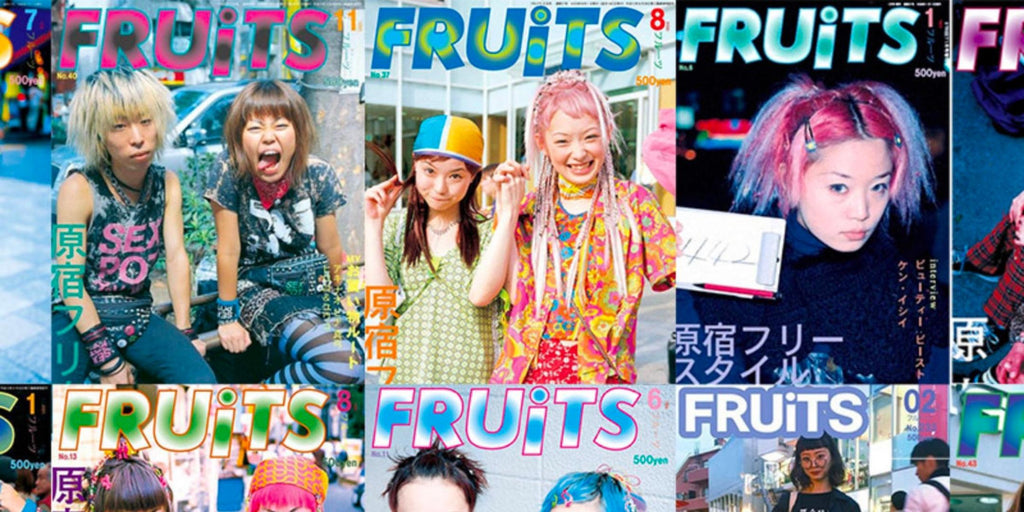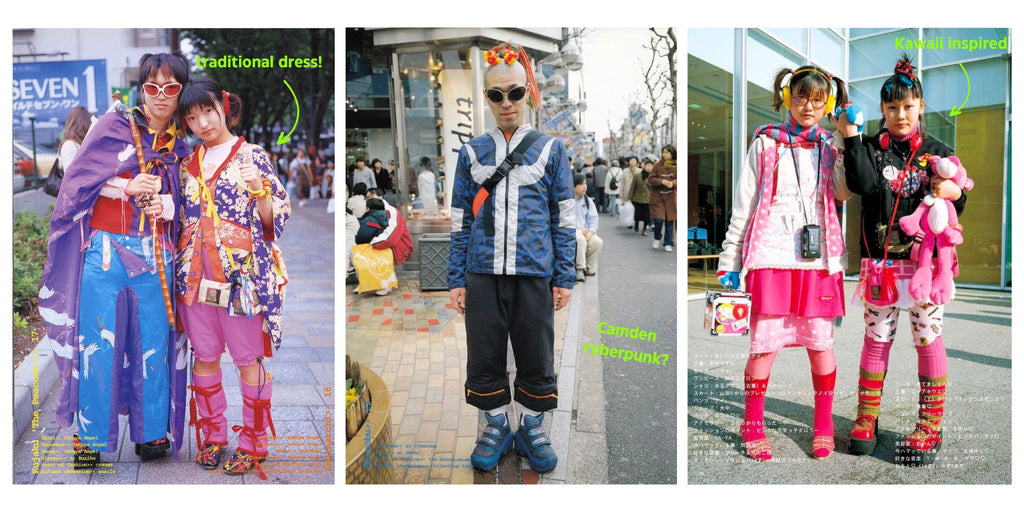FRUiTS Magazine: Harajuku Style, Vintage Clothing & Creativity
The news has hit - FRUiTS Magazine is back! The archive of the iconic Japanese style Bible has been reissued in English for the first time, showcasing the Harajuku style of the 90s to 00s in all its original glory.
What is FRUiTS magazine?

Multiple FRUiTS magazine cover over the years
FRUiTS Magazine was a Japanese street fashion magazine that was first published in 1997. The magazine showcased the latest trends in Harajuku, an area in Tokyo, Japan, and in particular the individual and quirky styles of its youth.
The magazine was founded by local photographer Shoichi Aoki. In 1990s, he noticed a shift in the way youth subcultures dressed in Tokyo’s Harajuku district which combined traditional, vintage streetwear, and DIY. Aoki decided to capture the various street styles, collating them into a monthly catalogue of photographs and vox-pop interviews.
What is Harajuku Style?

Snippets from Fruits Magazine c.2000
The ‘Harajuku style; is a Japanese style of dressing that first emerged in the 1980s in Tokyo's Harajuku district.
There is not one Harajuku style. It was all about creativity and pick and mixing different styles. Started by young people in Tokyo’s Harajuku district, they recalled different Japanese subcultures like Kawaii, Gothic Lolita, and Decora style, and mixed it up with contemporary Western styles like the Cyberpunk, 90s streetwear and brands like Vivienne Westwood and Adidas.
Traditional Japanese garments such as kimono, obi’s and sashes were all played with too. Aoki, the founder, remarked that the young people of Harajuku were the first generation to successfully and respectfully merge Japanese culture and western style where previous generations had failed.
Vintage stores and vintage clothing were at the heart of Harajuku style. It was all about finding a piece that resonated with the individual (Also... vintage clothing was way cheaper)
Why is FRUiTS magazine important now?

Left: DC Shoes, Centre: Two FRUiTS magazine snippets Right: Bella Hadid street style, insider.com
Although the original Harajuku style officially died out around the late 00s, its influence is still felt today.
Firstly, vintage clothing! Buying vintage clothes from previous decades, wearing your parents' clothes, and repurposing clothes was so important to the Harajuku style. Although more accepted now, choosing vintage clothing wasn’t that popular in the 90s. For the Harajuku kids, it was all about creating a style that was entirely unique to the person wearing it. Which is why one-of-a-kind vintage clothing was the one!
Trends like Maximalism can be traced back to Harajuku style too. The current fashion trend is all about DIY style and constructing / deconstructing traditional and trending styles to create something entirely new, big, and bold!
Looking at Fruits archives, you can see a lot of similarities between Harajuku style and Gen Z styles. The revival of the 00s or Y2K style is super popular now. You can see a lot of Harajuku kids wearing Y2K brands like Vivienne Westwood and DC Shoes. DIY clothing too! Like crocheted tops and hats.
The Future of FRUiTS
Shop ROKIT's Vintage Clothing Collection
Harajuku fashion has become a staple of Japanese fashion and continues to inspire fashion enthusiasts worldwide. Fruits Magazine played a significant role in the rise of Harajuku fashion and its subsequent global popularity. The magazine's comeback and introduction in the English language will surely revive a sense of nostalgia for the Japanese vintage clothing trend in the West. And we’re here for it!
Create your personal style with vintage clothing. Whatever resonates, whether that's getting yourself a vintage kimono, vintage streetwear shoes or a designer vintage piece.
